August 30, 2023 – Volume 25, Issue 8
In This Issue
- Flanigan’s Net Positive: Father of the Bride!
- Maine Boasts Lobsters… and Heat Pumps
- BTS Fans Take On Coal
- Seven Majors Form The Charging Coalition
- Porsche’s Charging Lounges
- Powering Rivian’s Adventure Network
- Rural Electrification: Yellow in Africa
- Flanigan’s Ego-Logic Podcast Updates
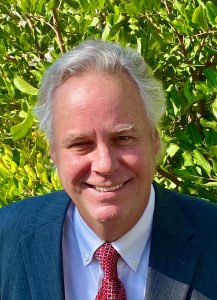
Flanigan’s Net Positive: Father of the Bride!
All eyes on the bride as we entered the chapel. What a thrill to be the father of the bride and to have the bride on my arm. And there was Jake at the altar, beaming like no one can beam, loving the sight of his bride-to-be walking up the aisle flanked by her parents. We’ve been trained to slow-pace our processional. Then the hand off… a quick kiss and hug and I take my spot in the first pew.
Like a few of us, I involuntarily tear up easily with joy. The kids’ graduations and performances have triggered my tears for years; sometimes items on the nightly news hit me. Admittedly so damned soft I am, embarrassingly so. But I did not want to be like my dear friend Alan who fell apart trying to toast his beloved daughter’s marriage. An emotional bust. That I was not going to do.
Throughout the weekend, family and friends were joyous, universally comfortable with this wedding couple’s match, a pairing as good as it gets. Skye and Jake are a wonderful fit of personalities, dynamic and devoted. They are both driven souls, super athletic, with big aspirations.

Prior to heading to the chapel for the wedding ceremony, Skye and Jake and immediate family and witnesses gathered for the reading and signing of the Ketubah, the Jewish wedding contract. Jake’s father Leonard read the Ketubah with the sincerity of deep tradition, with comfort and love.
The ceremony took place under the traditional Huppah, a wedding canopy framing the couple and the officiant, Cousin Liz. Skye and Jake’s voices were strong; their love and excitement so pronounced. Their vows were powerful and struck us all. I did tear up then. Some commitments were deep, others fun. Jake committed to recycling, folding at least some of his clothes, and buying an EV.
Skye and Jake are efficient project managers and the weekend-long celebration reflected that. Every detail was covered. Great meals and drinks; tours and tennis. The venue was spectacular, in the heart of the Hudson River Valley. Skye’ great-grandparents founded the prep school in 1931 to shape young men. They instilled a philosophy of life in them and throughout the school community: “non sibi sed cunctis”… “not for oneself but for all.” My mom, who attended the wedding, was one year old when Millbrook School was founded. She grew up on campus.
At Millbrook, every student is required to chip in, to have a role in community service. A most unusual student job at Millbrook is “zoo crew.” Millbrook has an accredited zoo that is open to the public. Students on zoo crew care for assigned animals come rain or shine, and sleet and snow. Daughter Sierra looked after endangered golden lion tamarins when she went to Millbrook. At different times all weekend, wedding goers walked down to the zoo, across the bridge at its entrance, over the rushing stream. A red panda was seen and photographed.
At the reception, I kicked off the speeches and focused on waiting for Jake… wondering who he would be. “Where’s Jake?” was the refrain. Was he from Laguna? From Millbrook? Skye went to college in Denver, semester abroad in New Zealand, worked in Boston, grad school in Cambridge. At every step, and as she matured, I kept wondering who would be right for Skye. “Where’s Jake?” When would he surface, become a reality, become part of my family? “Where’s Jake?”
What a band. Long before dinner was served, and well before the speeches, most guests hit the dance floor. Then the formal program began with the bride and groom’s dance. Shortly thereafter was the father/daughter dance. We were in step and deliberately slow as we gazed into each others’ eyes as we swayed and sang out, “What a Wonderful World,” the song made famous by Louis Armstrong.
Then the Hora dance, a Jewish tradition in which newlyweds are raised by the groomsmen and lifted into the air on chairs. The bride and groom went up and down riding like bucking broncos. Skye was not happy… later reporting that her dress was slipping and she feared a fall was imminent. Then Jake’s parents Marion and Leonard were raised into the air. They’d clearly done it before. I tried to slip into the shadows, but then it was my turn. Oh no! Fortunately my “chair-men” held a consistent angle for me, keeping me in my seat waiving a bandana in a victorious twirl.
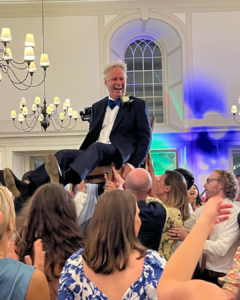
The dancing was wild… and we all cut it loose, the humidity reducing me. After the first set, Terry and I slipped off to our nearby dorm room to switch into jeans and party shirts. Then more dancing, weaving in and out and rocking with contingents from California, Colorado, Illinois, Massachusetts, Maryland/DC, New Mexico, North Carolina, Tennessee, Vermont, Ontario, and more. Some 175 of us gathered, witnessed, broke bread at five meals, and danced hard!
So proud of Skye and Jake. Their bond is spot on; the weekend was magical. They are immensely popular, and at the wedding they were showered with love. All parents attest forms of bewilderment as our off-spring become full-scale beings. We witness their drive and aspirations, their moods and energies, the circle of friends they make and keep. Skye and Jake have lots of family and friends that deeply support them.
What an honor to be the father of the bride. I hand off a dynamo! I gain a son! So pleased and lucky to report that I have a happy child and thus a happy heart.
Quote of the Month
“Our transition to heat pumps is creating good paying jobs, curbing our reliance on fossil fuels, and cutting costs for Maine families, all while making them more comfortable in their homes – a hat trick for the state.”
Maine Boasts Lobsters…and Heat Pumps

A year ago we were reporting on Maine lobsters and sailing the Maine coast. Well, Maine is still boasting lobsters… and now heat pumps.
The State of Maine embraced heat pumps as part of its climate action. Heat pumps are super-efficient means to heat homes. In 2019, Maine set a goal for 100,000 new heat pump installations by 2025. That goal has now been eclipsed two years early. There have been at least 104,000 installations. So Maine Governor Janet Mills is raising the bar. She’s calling for another 175,000 units by 2027.
The environmental benefits of pumping heat out of the air – in some seasons what little there is – and condensing that heat, cannot be overlooked. A Rocky Mountain Institute study found that heat pumps generate less than a tenth the emissions of conventional gas furnaces.
The State of Maine has around three-quarters of a million housing units, 751,782 in 2022. Thus 100,000 heat pump installations – while some homes will have more than one unit – represents a significant percentage of homes. Emissions from residential heating is 17% of Maine’s total GHG footprint. Thus heat pumps are poised to be a part of the solution in Maine, while saving the State’s 1.4 million residents money as they adopt this efficient technology.
Better yet is what Maine and other cold-weather states are proving about heat pumps: Contrary to the popular belief that heat pumps don’t work in cold climates… Mainers are proving that they do. They can eliminate fossil fueled forms of heating throughout the country without restriction year-round.
Efficiency Maine, which administers Maine’s heat pump rebate program, reports that it is tracking consumer satisfaction with heat pumps, where wind chill temperatures hit minus 60 last year. One 36-hour deep freeze in December of 2022 had overnight lows of -18 degree F and daytime highs of only 0 degrees F. Thousands of heat pump users were surveyed and reported that they were comfortable and warm. Heat pumps were able to maintain desired temperatures according to Elephant Energy, a home decarbonization company. And they were saving money too. One couple spent $100 to heat their home between November and April. They said that using an oil furnace would have cost them $3,000.
BTS Fans Take on Coal

There’s a long stretch of beach at Maengbang on the east coast of South Korea that was the site of a photo shoot for the K-Pop band BTS. It’s known as Butter Beach and it’s become a pilgrimage site for BTS devotees. To their shock and dismay, a gigantic coal plant is under construction just a few miles away.
The 2.1 GW coal plant has become a flashpoint for concern over the country’s continued use of fossil fuels. BTS fans and the broader K-pop community have been galvanized by the desecration of the land near Butter Beach and are now speaking out. There is a growing legion of K-Pop fans that state that, “We believe we have the power and influence to tackle the most devastating issue of our time – climate change.”
The protest group Kpop4plant formed with non-profit Korea Beyond Coal. Its members realize that their action will not be able to stop the Butter Beach plant, technically in Samcheok in the Gangwon Province. But their action may well influence South Korea’s President Yoon Suk Yeol and his climate change policies. To date he has favored nuclear and coal, and buying carbon offsets, over solar and wind developments in Korea. Fully, 7.3 GW of new coal is expected to come on line in Korea between 2020 and 2025.
Now an album cover, the desecration of a beach featured by BTS, has ignited community action. Having K-pop fans on board has taken the anti-coal campaign to the next level in South Korea, with unprecedented internet coverage and global attention.
Seven Majors Form the Charging Coalition

The Charging Coalition was announced in mid-July. Seven major auto companies have come together. They are joining forces to deploy at least 30,000 fast chargers across America on U.S. highways and other public sites. That would nearly double the 32,00 fast chargers now deployed as of July 2023.
BMW, General Motors, Honda, Hyundai, Kia, Mercedes Benz, and Stellantis formed the joint venture. These companies believe that the country’s existing fast-charging network remains woefully insufficient to support the millions of EV likely to hit U.S. roads in the coming years. The Biden administration has a goal for EVs to be half of new car sales by 2030. While most will be charged with Level 2 chargers at homes and apartment complexes, NREL projects a need for 182,000 fast chargers to support 30 – 42 million EVs anticipated to be on the road by 2030.
Mary Barra, GM CEO, noted that, “GMs commitment to an all-electric future is focused not only on delivering EVs our customers love, but investing in charging and working across the industry to make it more accessible.” She noted that the better experience, the faster that the EV market will grow.
Porsche’s Charging Lounges

Image Courtesy of Porsche
Porsche has opened the first of its EV Charging Lounges. It is looking to upgrade the charging experience for Porsche EV drivers with “exclusive premium amenities” such as free snacks and soft drinks, digital media, high performance wifi… even a smart mirror for a quick workout. The pilot site is outside Bingen am Rhein, Germany. Porsche plans to open its own network of fast-charging stations across Europe’s most important routes, offering its drivers the charging experience that, “one expects of the brand!”
At the pilot site there are six, 300 kW fast chargers and four, 22 kW AC charging ports. Next year Porsche may offer 400 kW super-fast chargers. Payments can be made through Apple or Google pay. The current price is 33 cents per kWh.
One needs a Porsche ID to access the charging lounge. The pilot location is open 24*7 and is in an area where there is significant traffic. The Porsche Charging Lounges will be displayed in the Porsche navigation system. The facility itself uses no fossil fuels. It has solar panels on the roof.
More lounges are slated for Germany, Austria, and Switzerland. So far, Porsche’s charging network consists of 436,000 charging ports in over 20 countries throughout the European Union. The company plans for 80% of its line-up to be EVs by 2030. Currently the company only has one EV for sale, its Taycan, noted recently for falling sales.
Powering Rivian’s Adventure Network

Rivian is not only making waves with its SUV, but now is backing a massive solar plant in Kentucky that is being built atop an abandoned coal mine. Rivian is the solar plant’s anchor customer, signing a 100 MW PPA with BrightNight, the plant’s developer. Rivian plans to use the power to supply its proprietary EV charging network, its “Adventure Network” of public fast charging stations. Rivian is committed to sourcing clean energy to do so. Its officials claim that the BrightNight deal is a “highly economic PPA.” The solar project will provide enough power for 450 million miles of Rivian EV driving every year.
One of the reasons that Rivian was interested in the plant is that it met the criteria of the Nature Conservancy’s Clean Energy Development Framework. The framework – presented in a report called “Carbon-Free: A Framework for Purpose-Led Renewable Energy,” embraces 3Cs – communities, conservation, and climate – not just least-cost power. “Projects should have strong community support, employ diverse local workforces, and incur location economic and community benefits. In this case, BrightNight’s use of reclaimed land, the project’s workforce development and economic renewal benefits, make it an attractive project to Rivian.
Symbolic indeed, the solar farm sits atop the site of an abandoned coal mine. The 800 MW BrightNight solar farm will be situated on reclaimed land at the Starfire coal mine, a surface-mining operation dating back to the 1960s that “cropped rolling Appalachian mountaintops into a series of leveled plateaus.” Mining continues in one corner of the parcel. BrightNight plans to cover 7,000 acres with solar panels, starting in 2027 and completing the entire project by 2030.
It’s big: The planned billion dollar solar installation will be the largest renewable plant at an abandoned mine. It may be the largest solar project east of Mississippi. The project will employ ~250 workers during construction phases, and BrightNight is committed to worker training for locals that have been hurt by the mine’s closure. The solar plant will provide a major boost to the region’s tax base, while its developers will tap the IRA’s special benefits for projects located in former coal communities.
Rural Electrification: Yellow in Africa

Pay as you go (PAYG) is now common in the developing world. For those without access to power, or access to phones or the internet, PAYG micro-financing systems are invaluable. They’re affordable. Let’s examine one company’s most popular offering:
Yellow provides a “small home solar system“ that consists of a 10-watt solar panel, a 50 Wh battery, four lights, a cell phone charger, and a radio. For these small systems, users make a $10 deposit and then pay off the balance in 6 – 24 months.
Yellow was founded in 2018 in Malawi by Michael Heyink and Maya Stewart. They saw a need: Malawi is a country marked by among the lowest access to electricity in the world. Yellow proudly boasts that it provides access to products and services that improve the quality of life of its customers. Yellow’s purpose is to make life better for customers living in Africa. It now finances solar and digital devices like cell phones in Malawi as well as Madagascar, Rwanda, Uganda, and Zambia. Through its digital technology platform, Yellow enables a distributed network of sales agents to serve rural households with life-changing products and services. It has 160 employees. To finance Yellow, its managers have raised some $45 million in the past 10 years, enabling its business model.
According to Gogla-World Bank report, there has been $2.3 billion investments in startups such as Yellow for solar energy financing serving the off-grid sector. They operate pay-go models asset-based financing. The solar kits and lantern products are hugely popular in SubSaharan Africa, a region where millions are off the grid, a region that accounts for 75% of the world’s population without electricity. One of the largest providers is M-Kopa. (See EcoNet News, Volume 12, Issue #7.)
More news from Africa. The President of Kenya, His Excellency William Ruto, recently inaugurated a new Roam electric motorcycle manufacturing plant. Founded in 2017, Roam is the leading provider of EVs in Africa. It is the first company to deliver locally produced electric motorcycles and buses, leading the transition to sustainable transportation in Africa.
Overlooking the Nairobi National Park, the Roam Park, is a new and expansive 108,000 square-foot facility that will produce 50,000 motorcycles each year. His Excellency noted that, “I am proud to inaugurate Roam’s electric motorcycle plant today. This facility showcases Kenya’s potential as a leader in clean transportation solutions in Africa.”
Flanigan’s Ego-Logic Podcast Updates

Use the links below to check out our recent podcasts. And you can always go to Spotify and type in “Ted Flanigan” to find our library of podcasts.
Recently Released:
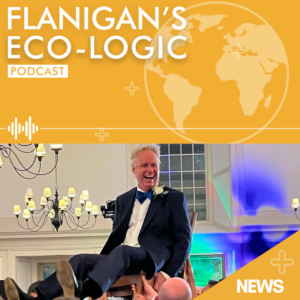
EcoNet News, Volume 25, Issue #8, highlights Ted’s daughter’s wedding weekend, and just how honored he was to be the father of the bride. Ted also highlights Maine boasting heat pumps, BTS fans taking on coal, the formation of the charging coalition, Porsche’s charging lounges, powering Rivian’s adventure network, and rural electrification in Africa.
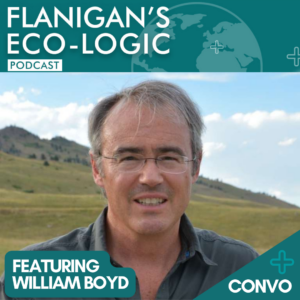
In this episode of Flanigan’s Eco-Logic, Ted speaks with William Boyd, Michael J. Klein Chair, Professor of Law at UCLA School of Law, and Professor at UCLA’s Institute of the Environment and Sustainability. He is also a Faculty Co-Director of the Emmett Institute on Climate Change and the Environment, and Project Lead for the Governors’ Climate and Forests Task Force (GCF).
His primary research and teaching interests are in energy law and regulation, climate change law and policy, and environmental law. He continues to be actively involved in climate, energy, and environmental policy matters at multiple levels of governance. Since 2009, he has served as the Project Lead for the Governors’ Climate and Forests Task Force (GCF), a unique subnational collaboration of 38 states and provinces from Brazil, Colombia, Ecuador, Indonesia, Ivory Coast, Mexico, Nigeria, Peru, Spain, and the United States that is working to develop regulatory frameworks to reduce emissions from deforestation and land use. Boyd is also the founding Director of the Laboratory for Energy & Environmental Policy innovation (LEEP), a policy innovation lab based in Boulder, Colorado that works with partners around the world to develop and support real-time policy experiments, establish robust networks for learning and exchange, and contribute to effective and durable policy outcomes.
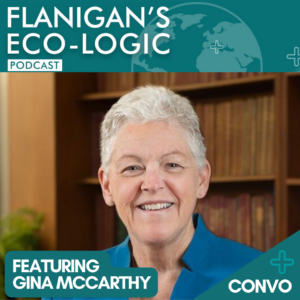
In this episode of Flanigan’s Eco-Logic, Ted speaks with Gina McCarthy, the first-ever White House National Climate Advisor under President Biden and former U.S. EPA Administrator under President Obama. She is one of the nation’s most respected voices on climate change, the environment, and public health.
As head of the Climate Policy Office under President Biden, McCarthy’s leadership led to the most aggressive action on climate in U.S. history, creating new jobs and unprecedented clean energy innovation and investments across the country. Her commitment to bold action across the Biden administration, supported by the climate and clean energy provisions in the Bipartisan Infrastructure Law and the Inflation Reduction Act, restored U.S. climate leadership on a global stage and put a new U.S. national target to cut greenhouse gas emissions by 50-52 percent below 2005 levels by 2030 within reach. Throughout her years of public service in both Republican and Democratic administrations, McCarthy is credited for her common-sense strategies and ability to work across the aisle, with states, communities, business leaders, and the labor community, to tackle our nation’s toughest environmental challenges in ways that spur economic growth, and improve public health for workers and families, especially those living in environmental justice communities.

In this episode of Flanigan’s Eco-Logic, Ted speaks with Esha Chhabra, Author of Working to Restore: Harnessing the Power of Regenerative Business to Heal the World. Esha is an accomplished author who specializes in writing about sustainability, international development, and the emergence of mission-driven brands. In the last decade, she has made significant contributions to numerous national and international publications, such as The Guardian, New York Times, Wired UK, Washington Post, Atlantic, Fast Company, Forbes, Stanford Social Innovation Review, and more, establishing herself as a prominent voice in her field. Her writing offers insightful perspectives and nuanced, thought-provoking analyses of pressing issues. Her work has been supported by the UN Foundation, and has been awarded multiple fellowships from the Pulitzer Center on Crisis Reporting in Washington, D.C.
Her latest book is one of the first of its kind. It is a journalistic work with a series of case studies across industries that sheds light on the businesses which have restorative and regenerative practices at their core, going beyond the greenwashing to a shift in mindset that is helping heal the world. She describes her travels and the entrepreneurs and activists she met across the world, hitting every continent except Antarctica. She also unpacks the social and environmental innovations in relatable industries that people have everyday interactions with, such as coffee, shoemaking, healthcare, energy, and hospitality, highlighting companies that are genuinely doing the work and part of a global movement.

In this episode of Flanigan’s Eco-Logic, Ted speaks with Jenny Tse, founder and owner of Sipping Streams Tea Company. Jenny is also the best-selling author of The Essence is Tea: The Transformational Journey of a Tea Connoisseur, and the host of the Essence of Tea podcast.
Her company began as a vision in 2004 when Jenny was making a career pivot from teaching high school and noticed the way that tea was able to bring different people together. Jenny’s passion for community, sustainability, and quality have allowed the Sipping Streams Tea Company to specialize in high-quality organic loose leaf tea, tea education, and running a specialty tea shop. Every blend is handcrafted and curated to be unique and fresh, and sourced directly from all over the world. Sipping Streams emphasizes the importance of sustainability through packaging, and especially with their non-GMO compostable pyramid tea sachets. In 2021, Sipping Streams Tea Company started the first ever tea farm in Alaska, and the only geothermal powered tea farm in the world. Jenny highlights the environmental and social impacts of tea.

In this episode of Flanigan’s Eco-Logic, father-daughter duo, Ted and Sierra Flanigan host the clean energy crash course focusing on the Millbrook solar story, a project in which all the stars aligned. Not only did the solar system take a huge chunk out of an institution’s carbon footprint, but it was a good deal from the start, no money down and first year savings of over $50,000.
They start at the very beginning of the story, first sharing their family history – Ted being the grandson of the founder – then fast forwarding to 2013 when the solar system story begins. They then dive into the first steps: sizing the solar system, netting out efficiency, providing capacity for additional geothermal, and figuring out where to put the system.
They also discuss financing. The goal was to finance the system and to save money. Ted explains the Benefactor Investment Model that was developed for the project, giving credit to Millbrook Alum Mark Hopkinson. However, thanks to a New York State Grant, the system was ultimately financed with a highly favorable PPA.
Ted concludes by sharing the challenges and solutions along the way, as well as the next steps for Milbrook. He thanks all the key players for the success of the solar story.
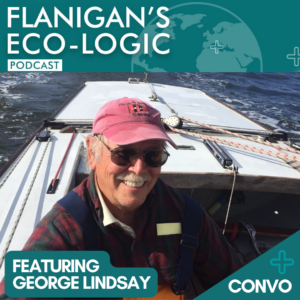
In this episode of Flanigan’s Eco-Logic, Ted speaks with George Lindsay, Jr., President of the Christeen Oyster Sloop Preservation Corp, a non-profit in Oyster Bay, Long Island with the mission of preserving Oyster Bay’s Marine Heritage by involving the community in traditional boat building.
George is a lifelong resident of Oyster Bay and Cold Spring Harbor, New York. He and Ted discuss the launch of the Ida May, the first diesel powered oyster-dredging ship, which he rebuilt from scratch with other community members. They also discuss the health benefits of oysters, the history and preservation of oysters in Oyster Bay, and the future of Oyster farming.
